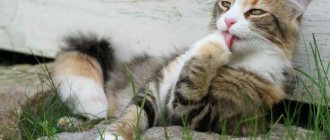Box through the eyes of a cat: what is it
A small box is perceived by the animal as a house, an opportunity to hide, because naive cats are sincerely convinced that if they do not see the danger, then, therefore, they themselves are invisible to it. This belief, as well as the desire to curl up in a ball and keep warm, forces pets to climb into boxes that are uncomfortable from the owner’s perspective and sit in them. And numerous collections of photos from the “Cats and Boxes” series prove that this sympathy is very widespread.
Purebred cats often prefer ordinary cardboard boxes to fashionable beautiful beds
Ambush game
Climbing into a box, the cat sometimes hides from us, only to attack later unexpectedly. After all, cats are predatory animals. They always enjoy such games. They climb into the box, thinking that no one notices them. Then the pets wait for their prey and jump out noisily. This brings joy to little hunters, so why not play along with them? It is important for them to remember their instincts. After all, domestic animals have so few reasons to show their true predatory nature. Don't deprive them of such a little prank. But the box will be able to distract them from peeling off the wallpaper or destroying your favorite leather chair.
Reasons for love
Cardboard containers are perceived by pets as a house, which is why cats love boxes. They are comfortable here, safe, it seems that nothing is in danger.
The desire to avoid problems in communicating with the owner
Why do cats love boxes so much?
Cats are independent animals that value personal space. They may truly adore their owner, but need a break from him from time to time. This is where the box in which the cat hides in order to temporarily retire becomes relevant.
Nashkodiv, a pet, in an effort to avoid deserved punishment, can also hide, believing that if the owner does not see him, he will not guess where to look.
Note! Some people maintain the illusion in their pets by adhering to the rule: if the cat has reached its “place”, then it cannot be punished.
Privacy and feeling of security
A small box, into which a large animal can hardly fit, creates the feeling of a mink, a cave where the pet can warm up. That is why those who have several cats can from time to time enjoy an amazing sight: all the pets are trying to occupy one box, literally lying on top of each other. You don’t have to think that they are suffering; on the contrary, in this way the cats warm themselves and feel safe.
Important! A small box gives them something that a beautiful, expensive house cannot provide - a sense of security.
The reasons why cats love the most inconvenient boxes have not been studied enough by scientists to this day.
Attractive smell
The scent of cardboard that cats go crazy for is another reason why cats love boxes. Scientists were able to find out that cats really like the faint smell perceptible inside the container, which is why they tend to sit in their shelter more often and enjoy it.
Nostalgia for childhood
Cats, like people, come from childhood. They also want to feel like kittens again, cared for by an attentive mother cat. That is why they climb into small boxes that remind them of the one in which they were born a number of years ago.
Why do cats climb into boxes?
It is difficult to understand a cat's psyche, moods and desires. It is difficult to study them, as well as to understand the results of experiments conducted on them. However, research has revealed the following - murks strive for secluded places, looking for comfort and safety.
Research is good, but as know-it-all cat owners, we are no less curious and also want to know why cats like to sit in boxes and bags, considering all the possible options. Let's start with the simplest versions.
Ambush game
When a cat hides, we perceive it as just another prank. The little predator doesn’t think so; he is now catching his prey. You can’t escape instinctual needs, and our cat’s distant ancestors got their food from ambush. Why is the box not a shelter for a surprise attack? So the pet lurks, preparing to pounce. If you want to check, walk past the shelter and with a high degree of probability a lightning attack will be made on your leg.
Ear for music
I think many people have noticed that cats love rustling objects. You know why cats and cats like boxes - right, because of their wonderful rustling sound.
You can often notice that a pet, having taken a fancy to a bag or cardboard shelter, begins to dig and bite corners there. By the way, cats love to chew on boxes for the same reason. And if you do this inside, the sound is also amplified due to the echo.
Hide and seek from society
The cat is not a strategist in the field of resolving conflict situations. It is easier for her to avoid meeting a possible enemy. That's why cats climb into boxes not to solve problems, but to hide from them. But even in a great mood, Murka also does not shy away from cardboard fun.
Personal space
If you are wondering why cats love boxes, then it will not hurt to know that for a pet, having personal space is just as important a factor as for a person. Having taken a fancy to a cardboard shelter or even a package, the pussy “settles in” in its place, a personal room, saturated only with its aromas. So, if you notice that your pet’s interest in the box is more than idle, arrange a home for him. A warm pillow along with a favorite toy will take your cat to the skies.
The smell of cardboard is a habit
Cats are often housed in boxes after lambing. In this case, the smell of cardboard is one of the first, and therefore familiar, aromas that the kitten remembers. In addition, the smell of childhood reminds a purring mother. In addition, the boxes are made of paper, which, in turn, is made of wood - a natural material that reminds your pet of wild roots. This is especially true for cats that are never outside.
Feeling of security
It may sound ridiculous, but cats' love of solitude and boxes is often based on this factor. Conduct an experiment, place several boxes of different sizes in front of your pet, and he will definitely climb into the one that is ideal for him in size. But even if there is nothing suitable for the dimensions of the mustache, he will make every effort to fit there at least partially.
It is believed that cats completely relax in boxes. Instincts tell the pet that a dense environment is protection, similar to natural shelters, such as a hollow in a tree.
Why do cats like to sit in boxes and people like to look at it? But this is a whole lot of fun not only for the fluffy one, but for all family members. The performance can be made even more colorful if you use your imagination. Cut several different holes in the box or build a cat house out of cardboard and see how enthusiastically your pet will begin to master the new structure.
How to tell if a cat likes a box
Having decided to please his pet, the owner can put a cardboard box for him. It is quite simple to understand that she liked it - the cat will strive to be inside as often as possible.
Why do cats stand on their paws when they fall?
Having brought the container home, you should show it to your pet; after a while you will notice a keen interest.
Important! If the cat does not pay attention to the new product or sat in it for several minutes and never returned, then it can be safely disposed of, since for some reason known only to the cat, the pet refused the gift.
Why is a cat interested in paper?
An uncontrollable desire to eat inedible objects, noted in the international classification of diseases as parorexia, sometimes develops in pets due to stress or disturbances in the functioning of the gastrointestinal tract.
Felinologists who study the behavior of cats identify the following main reasons for eating paper products:
If a pet eats foods rich in protein, then against this background it develops such cravings.
- Pain in teeth. If a cat has an inflammatory process in the oral cavity or the process of decay has begun, then with the help of constant chewing it relieves pain.
- Accumulation of fur in the gastrointestinal tract. Lumps of paper act as an alternative to fresh grass, which the pet uses to cleanse the body in the natural environment.
- Incorrectly selected diet. If a cat's diet lacks carbohydrates and minerals, it will develop cravings for inedible food. Most often, the disorder is caused by eating only protein foods.
- Setting boundaries. When a cat tears and scatters pieces of paper around the apartment, according to the observations of felinologists, it is marking its territory.
- Constant exposure to stress factors. Your pet may experience a depressed mood due to insufficient home improvement, the departure of one of the owners, or a change in the daily routine. To suppress negative emotions, the cat chews inedible objects.
- No load. Chewing paper acts as a substitute for active games if the pet does not have the opportunity to run and jump. You can equip your cat with a special corner by installing empty boxes.
- Boredom. When a cat has nothing to do, it can attract the attention of its owners by chewing paper sheets. The pet needs to pay more attention and buy toys.
- Pleasant smell from paper. When cats show interest in specific sheets, there is a chance that tasty food or flavorings have been placed on them.
Pros and cons of this behavior
Why don't cats smell?
The main positive aspect of the fact that cats adore boxes is the availability of the latter. Owners do not have to spend money on expensive houses; it is quite enough to take a suitable container and make a hole for them.
Note! The box can be replaced with a bag, basin, basket - the item that your pet will perceive as home.
A regular box is the simplest, cheapest option for a house that your cat will be delighted with.
Other advantages:
- having its own home makes any domestic cat more sociable and calm;
- when the owner is not at home, the pet will not be sad and lonely, he can crawl into his hole and sleep.
However, such love of cats also has negative aspects:
- Often mustachioed beauties take a liking to those boxes that the owner needs, for example, for shoes or clothes. And those that were brought especially for them are ignored;
- cardboard is a fragile material, if a pet starts gnawing on it, then the garbage will inevitably scatter throughout the apartment, creating additional worries for the owner;
- the box is a refuge; the cat sitting in it is not visible. She can suddenly jump out, frightening a person.
Despite the disadvantages, the cat, for whom the box has become a home, looks very funny.
Why do cats love boxes so much?
Cats love cardboard boxes - size and color don't matter! Our cats may prefer this simple and very inexpensive accessory to the most expensive and advanced toys. For a normal psychophysical state, it is vital for them to settle down in confined spaces, and banal penny cardboards are the most convenient option for this.
Cats choose cardboards - and do the right thing!
Why is this so? There are many versions, but there is no clear answer. But don’t let this stop you from giving your pet another box in which he will feel:
- comfortable and warm;
- interesting and fun;
- calm and reliable;
- cozy, like in childhood.
What I think about is how beautiful I am
A love of boxes is a trait of all cats.
An inexplicable love for boxes is inherent in all cats, not just our pets. Many zoos and safari parks are now actively offering the boxes they adore to large predators.
Photo gallery: packaging for a big cat
The box is an ideal place for an ambush
Nothing can be done against nature - our charming domestic, completely tame cats, by nature, were and remain passionate hunters. In natural habitats, many feline predators can hide in shelters for a long time, waiting for prey, and then, choosing an opportune moment, quickly attack from an ambush.
A cardboard box is the best springboard for an attack
But a lazy apartment cat, who has neither enemies nor prey, can easily put on a show in which the terrible enemy will be a towel falling on the floor, and the prey, for example, will be the owner’s legs... And our hero will spectacularly begin to jump out of the box, take incredible poses and fearlessly rush to attack! However, you have probably observed all this yourself, and more than once.
In a protected box
Pleasant childhood memories of cats - about an affectionate mother, tasty milk, funny games with brothers and sisters - are most often associated with the cardboard box where the “birthing center” was set up. That is, the box seems to them to be an ideal shelter in order to escape from various stressful situations.
For kittens, a box is a home
The nature of an adult cat is such that, unlike a dog, it prefers not to solve problems that have arisen, but to get away from them. In this sense, a magic cardboard box is an ideal shelter, because it helps not only to hide from reality, but to briefly return to a happy, problem-free childhood, where all difficulties were solved as if on their own.
No matter how hard cats try to seem proud and self-sufficient, they really miss their owners. When you leave home for the whole day to go to work, in your haste you often forget to even pet your pet goodbye. And he will become sad all the time while you are gone.
Master, I miss you - come back to whom you told!
Video: cat hide and seek
Box - heat generator
Cats are very thermophilic. And this is by no means a whim of a pampered animal - the temperature comfort zone for a cat is in the range from 30 to 36 degrees, which is much higher than the usual human norm. That’s why pets so often cling to their owner, his warm hands, and love to crawl under the blanket with him.
Who is where - and I’m in the house, it’s warm here
Due to the peculiarities of its structure, corrugated cardboard acts as a thermos and retains the cat’s body heat well. Hence the funny predilection for cramped, obviously oversized cardboard boxes - they simply have less heat loss. This same property of cardboard boxes also explains how elderly animals with sore joints like to climb into them: they set up a “physiotherapy room” here with warming up their paws.
Boxes help keep cats much-needed warmth
Indifference to packages
Cats are smart, they gradually understand that if the owner came home with a bag, then it might contain food - that's why cats love bags. They hope there is something tasty in them.
Note! When in contact with an animal's fur, a plastic bag creates a special effect that is pleasant to the pet.
Feeling like a hunter
This is another reason why cats love bags. They return to their natural state of predators, because a rustling bag can be caught like a mouse and played with for a while. Fun is the main reason for the amazing love for all kinds of bags.
Finally, the craving for packages is often due to a more transparent reason - previously it contained meat or fish, the smell attractive to the animal was preserved. That is why the cat strives to get and lick the bag.
Sacks and packages are the second weakness of muroks
Finding a safe place
The way of life requires animals to find a safe shelter. Wild cats sleep most of the day. This is how predators save the energy needed for hunting. While resting, they need a safe place, protected from other animals. In nature, they climb trees, find holes, and hide in bushes.
At home, pets do not require such tricks. But instinct pushes us to search for shelter, explaining why cats love boxes and bags.
Even a small object seems like a suitable place for them to hide. A cat can settle into a box that only fits its paws and feel comfortable. The pet is calmed by the presence of limited space. Scientists have shown that access to boxes reduces stress in pets.
Shelter provides a feeling of security - the cat understands that it will not be attacked from behind or from the side. All potential threats must be brought into view.
An enclosed space becomes a cozy couch. But only if the cat got there voluntarily. Forcible attempts to place your pet in a carrier or bag will be met with aggression. But the cat can explore the same container on its own and choose it for sleeping or resting.
It is worth giving mousecatchers a choice of several hiding places. When bringing a cat home for the first time, it is advisable to release:
space under the bedside table (table);
a place in a closet with an easy-to-open door.
The animal will choose the offered shelter or find its own. So, the cat will hide in a constantly forming pile of clothes for ironing, a box under a folding chair (sofa). The presence of stationary shelters will not affect the interest in abandoned boxes (packages).
The curiosity that boxes and bags evoke
The packaging brings an abundance of smells. This is one of the reasons why cats lick bags. They also leave traces of the contents. Animals are attracted to the smell:
So, a cat will climb into a box of bleach, a product containing chlorine. Pets are attracted to new scents, especially those containing traces of other animals. The cat will show increased interest in a country box, a bag that has been in contact with the local fauna.
For pets, packaging becomes a source of information about the outside world. The contents, places of injury and production leave aromatic traces that can interest the pet. Having climbed into the box, the cat receives information about other places without leaving the room (yard).
Hunting or game
Entertainment is an additional reason why cats lick bags. In addition to food debris, the material attracts them by rustling and pliability on the claws. A cellophane bag becomes a favorite toy until it becomes unusable. Attracted by a scent or hiding space, the cat climbs into the bag.
The rustling light material is an interesting prey. The cellophane moves with a slight blow or push, prompting the animal to enter into a “fight.” Cats also see other packaging as a potential toy. How they are attracted to a surface for sharpening their claws:
- polystyrene foam, other foamed plastic;
soft woods.
The materials are used to produce containers where cats can hide: completely or “nominally”, climbing into a box without a lid or a box with large holes. From a hiding place, the pet can hunt others. Structures made of soft materials allow for additional improvement of the shelter. The pet tears off pieces of the structure, creating additional toys; makes holes, creates grooves, sharpening claws.
Dangers that an animal may encounter when playing with bags
After playing, your pet may tear the bag and swallow part of it. Polyethylene is very negatively perceived by the cat's digestive tract, especially if the animal is older than 7 years.
Important! Self-medication and attempts to induce vomiting are unacceptable; it is important to contact a veterinarian as soon as possible.
A piece of cellophane stuck in the throat can cause a cat to suffocate, so postponing a visit to the clinic in the hope that it will go away on its own is unacceptable.
Sacks, boxes, bags - these are the best resting places for cats
Cats and boxes have long been a popular subject for Internet videos and photo collections. Animals really like the opportunity to climb into a cardboard container, curl up inside and watch from the side the amazement that inevitably arises from the owner. A good idea is to lay an old warm jacket on the bottom to keep your pet warm and cozy. The cat will certainly thank the owner for such care by purring.











